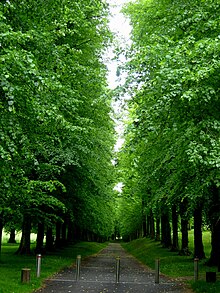Tilia x europaea
| Tilia × europaea | |
|---|---|
 |
|
| Avenue of common limes, Hampshire, UK. | |
| Scientific classification | |
| Kingdom: | Plantae |
| (unranked): | Angiosperms |
| (unranked): | Eudicots |
| (unranked): | Rosids |
| Order: | Malvales |
| Family: | Malvaceae |
| Genus: | Tilia |
| Species: | T. × europaea |
| Binomial name | |
|
Tilia × europaea L. |
|
| Synonyms | |
|
|
Tilia × europaea, generally known as the common lime (British Isles) or common linden (North America), is a naturally occurring hybrid between Tilia cordata (small-leaved lime) and Tilia platyphyllos (large-leaved lime). It occurs in the wild in Europe at scattered localities wherever the two parent species are both native. It is not closely related to the lime fruit tree, a species of citrus.
Tilia × europaea is a large deciduous tree up to 15–50 m (49–164 ft) tall with a trunk up to 2.5 m (8 ft) radius. The base of the trunk often features burrs and a dense mass of brushwood. The leaves are intermediate between the parents, 6–15 cm (2–6 in) long and 6–12 cm (2–5 in) broad, thinly hairy below with tufts of denser hairs in the leaf vein axils. The flowers are produced in clusters of four to ten in early summer with a leafy yellow-green subtending bract; they are fragrant, and pollinated by bees. The floral formula is ✶ K5 C5 A0+5∞G(5). The fruit is a dry nut-like drupe 8 mm (0.3 in) diameter, downy and faintly ribbed.
This hybrid is very widely cultivated, being readily and inexpensively propagated by layering; as a result, it is often the commonest Tilia species in urban areas and along avenues and streets. It is not however the best species of this purpose, as it produces abundant stem sprouts, and also often hosts heavy aphid populations resulting in honeydew deposits on everything underneath the trees. Furthermore there is substantial leaf litter in autumn (fall).
One long-lived example was the "Malmvik lime", planted as a sapling near the Malmvik Manor in , Sweden in 1618. The tree existed for 381 years until the last part of the tree fell in a storm in 1999. The UK TROBI Champion is at Aysgarth, Yorkshire, measuring 26 m in height and 295 cm d.b.h. in 2009.
...
Wikipedia
